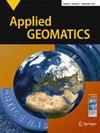Extracting urban patterns in undulating landscapes from SAR data with thresholding approach
Abstract
Urban footprint extraction is used for the extraction or classification of various land use classes like water bodies, urban areas, vegetation, and others over any region. But this is quite difficult to perform in the hilly terrains. The work recognises the optimal threshold value for the extraction of urban features is based on the coherence properties of the processed SAR dataset. The work utilises two Sentinel-1 A satellite images acquired on 7th January 2020 and 31st January 2020 respectively. The work of urban footprint is accomplished with (a) the creation of a coherence image with a pair of SAR imageries; (b) further pre-processing of the coherence image to apply multi-looking and terrain correction; (c) the derived coherence image is stacked to create a false colour composite image to provide an input for feature extraction; (d) feature extraction is performed by masking out the urban areas at different thresholds levels. The results of the extracted urban footprint are authenticated with a comparison to the optical dataset. Some sample locations are selected for validating the results from Google Earth historical imagery. Results indicate that the urban features extracted at a threshold value of 0.5 provide improved results in comparison to the threshold values of 0.4, 0.6, and 0.7. The pixels of urban features at a coherence threshold of 0.5 are lying at the same position where urban areas are present. The work can be further propagated for the identification and monitoring of other urban features regardless of any weather conditions for several other applications.

 求助内容:
求助内容: 应助结果提醒方式:
应助结果提醒方式:


